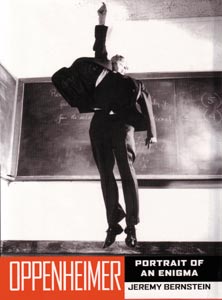by Jeremy Bernstein, Ivan R Dee. Hardback ISBN 1566635691, $25.

Jeremy Bernstein, theoretical physicist and erstwhile science writer at The New Yorker, targets “readers whom I do not assume to be scientists, but whom I do assume to have intellectual curiosity”. With Oppenheimer: Portrait of an Enigma he aims true. Portrait is an engrossing collection of vignettes of the great and the good (and the not so great and not so good) who took part in a scientific project that changed the world like no other: building the atomic bomb. Woven into the story are lucid exposés of those 20th century sciences that informed the project, as well as many insights into the geopolitical upheavals that were provoking and being provoked by it.
Portrait is less fraught with witch-hunting and soul-searching than earlier accounts of the same events. After passing sensitively through Oppenheimer’s somewhat strange and sad childhood, Bernstein treats his readers to splendid tales of “Oppie” as sartorial aesthete, polyglot, poet, lover, homicide manqué, “leftwanderer”, brilliant physicist, serial show-off and cruel critic, an insecure genius with a profound need to be admired. The supporting cast includes military and political stars, and most of the glitterati of early quantum, atomic and astrophysics, from Alvarez to Zwicky.
Though firmly in the Oppie fan club, Bernstein remains even-handed in drawing a fascinating profile of a complex man. The fellow he depicts is not particularly nice but undeniably charismatic, a magnet with both poles fully exposed, admired and hated equally. Unfortunately for Oppie, times were such that his enemies could be dangerous. Pivotal episodes are his unlikely appointment as director of the Los Alamos Laboratory in 1943 – “he had never managed anything” and “had a ton of left-wing baggage” according to Bernstein – and his almost self-induced downfall during the following years. His disgraceful testimony to the House Un-American Activities Committee in 1949 and bizarre conduct during his own “trial” before the Atomic Energy Commission (AEC) in 1954, when he finally lost his security clearance, are candidly presented and carefully analysed. In 1947 Oppenheimer was made director of the Institute of Advanced Study in Princeton, where Bernstein was later to meet him. The cold-war arms race proceeded without him.
Though not mentioned, in CERN’s 50th birthday year it is fitting to recall that several “men of science” who came out of the Manhattan Project with a feeling of “blood on their hands” were determined that things would be different for future generations of researchers. While Oppenheimer was being investigated by the AEC, his close friend Isidor Rabi and others were working through UNESCO to create CERN, a European laboratory where physicists could conduct “nuclear research of a pure scientific and fundamental character…[having] no concern with work for military requirements.”
Portrait prompts other sobering reflections on “then” versus “now”. For example, in July 1945 the Franck Report premised that bomb technology could not be kept secret and that it was only a matter of time before other nations would have nuclear weapons. A scant four years later Russia exploded its first nuclear bomb. In June of this year Mohamed El Baradei, director-general of the International Atomic Energy Agency, speaking at a conference hosted by the Carnegie Endowment for International Peace, said: “we are actually having a race against time…not only with regard to countries acquiring nuclear weapons but also terrorists getting their hands on some of these materials, uranium and plutonium.”
Portrait is full of personalities and is entertaining and thought-provoking. If cavils there must be, there is a brief lapse of clarity concerning fusion, later redressed, and the timeline is sometimes confusingly broken or looped, but these are minor quibbles not major complaints.







